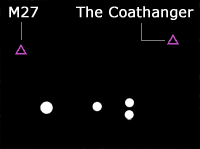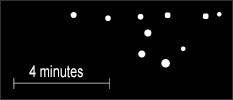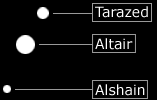

These three stars comprise the "Family of Aquila" or "The Balance". Altair spins so fast on its axis (one complete rotation in 9 hours, compared with the twenty-five days that our sun takes) that professional astronomers have deduced that it has a highly flattened shape:

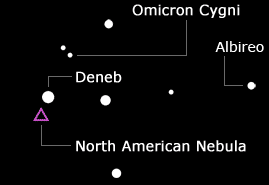
North American Nebula NGC 7000 - Occupies the most beautiful area of the northern Milky (Click here and here for photographs). Harrington points out that although the nebula is visible in binoculars it is most easily seen with the naked eye as "a slighly brighter, detached portion of the Milky Way just east of Deneb".
Double Stars Albireo and Omicron Cygni - Cygnus has two wonderful binocular double stars, both pairing yellow and blue suns. Albireo is the more famous double ("Just divided with bood binoculars" - Muiden), but I much prefer Omicron ("a magnitude 4.0 yellow star showing brilliant contrast with its wide, blue magnitude 5.0 companion ..... one of the most colourful binocular doubles of all" - Muirden). When looking at Albireo through binoculars I remember Burnham's comment " .... at least 55 solar systems could be lined up, edge-to-edge, across the space that separates the components of this famous double!"
Globular Cluster M13 - Circular misty patch in binoculars. Believed to contain one million stars and be over 10 billion years old! In 1974 a radio message was sent towards M13 from the Arecibo radio telescope - the earliest we might expect a reply is in 50,000 years!
Globular Cluster M92 - Smaller and fainter than M13
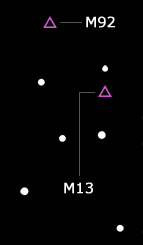
Vega - is a rapidly spinning blue/white star with a bulging equator, although in fact we are looking down on one of the star's poles.
Double Star Epsilon - The famous "double-double" sadly needing a telescope to split the main components into four stars rather than the beautiful pair visible in binoculars.
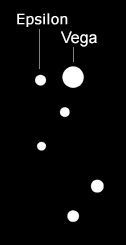
Wild Duck Cluster (M11) - "Light from the time of Stonehenge"

Dumb-bell Nebula M27
|
|
- Ghostly globe of light. As well as looking spectral to the eye in binoculars, the Dumb-bell also haunts the mind because it shows us how our own sun will be in billions of years time. The nebula is the result of an ageing star collapsing inwards as it runs out of nuclear fuel. The core becomes compressed and heats up under the pressure of the collapse, this heating in turn blows the outer layers of the star into space. It is this discarded material that we see in binoculars. The nebula glows because it is powered up by radiation streaming from its parent white dwarf star. |
Asterism Collinder 399 - The Coathanger, a.k.a Brocchi's Cluster. A summer favourite! Data obtained from the Hipparchos satellite suggests that this group is a chance asterism rather than a true cluster.
